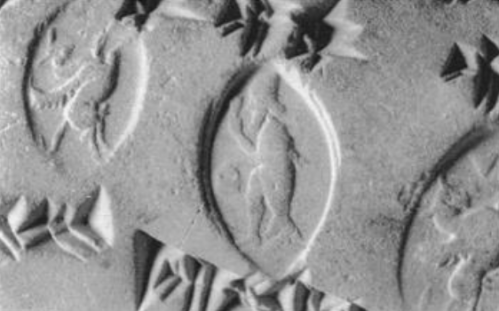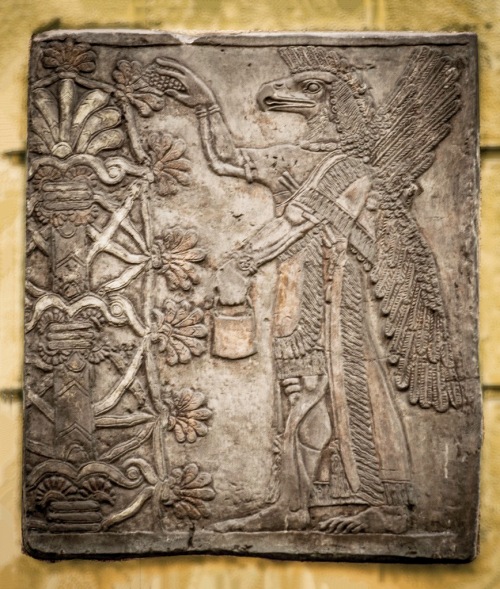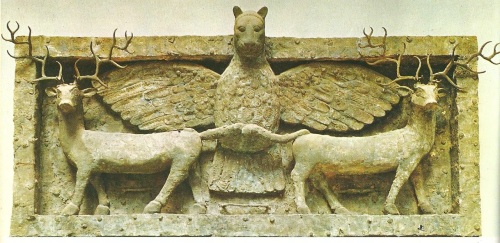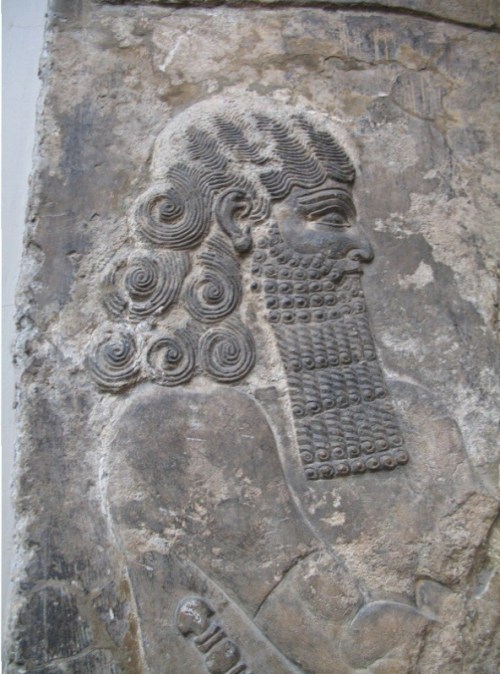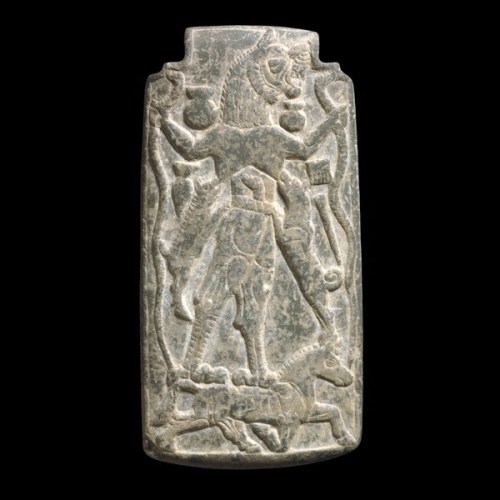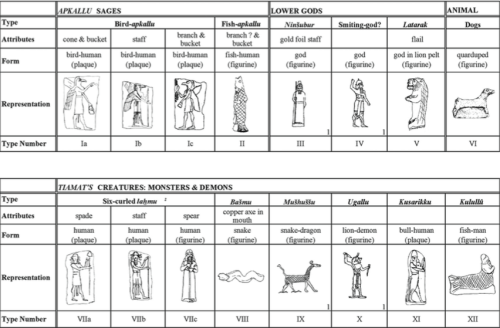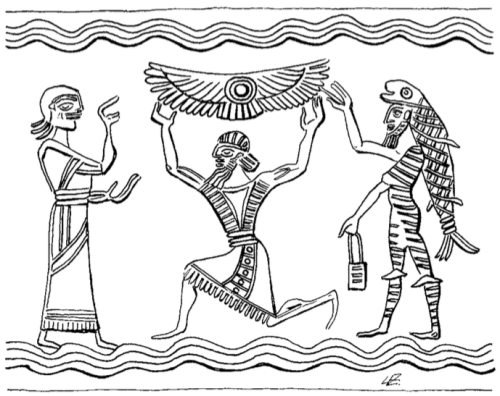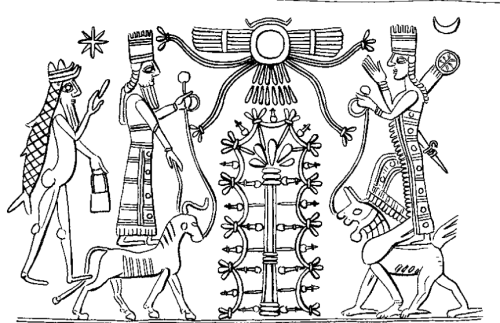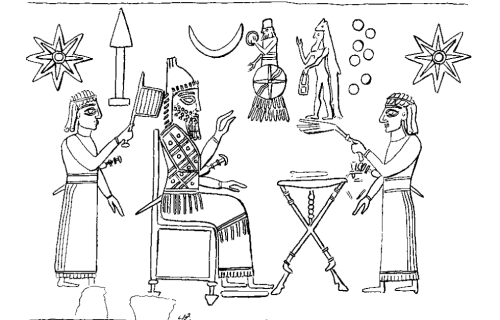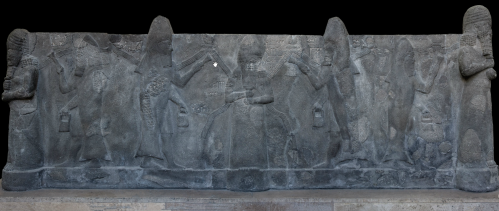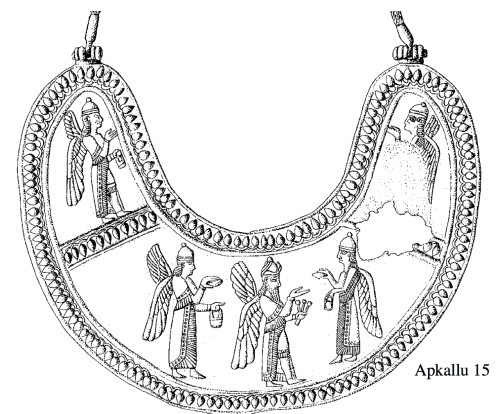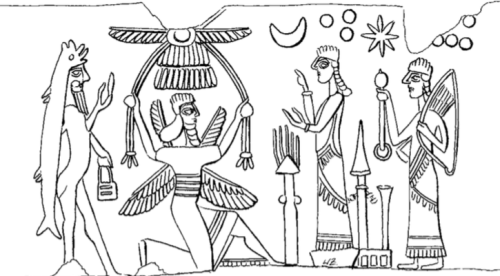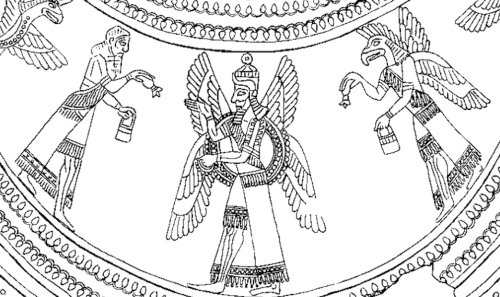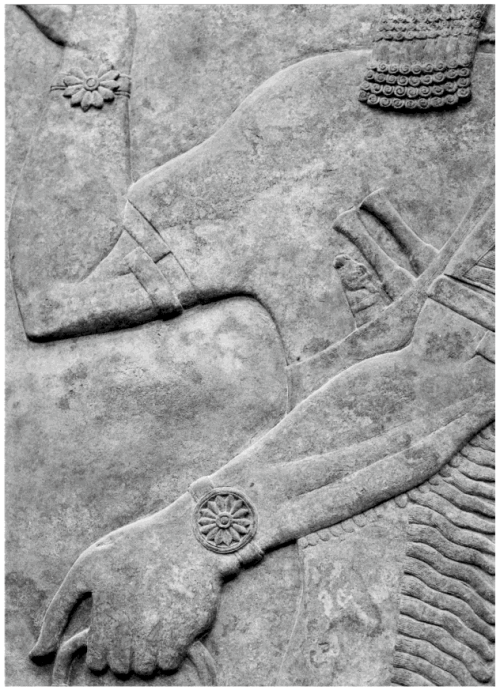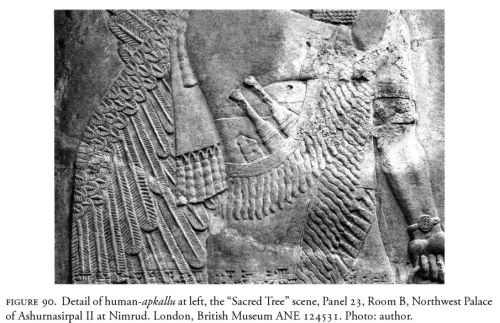“This hybrid sage (7, 21, 36*, 39*, 67–80), also called griffin-demon, Nisroch, or simply genie, is a human body with the head of a bird of prey (perhaps an eagle or a vulture).
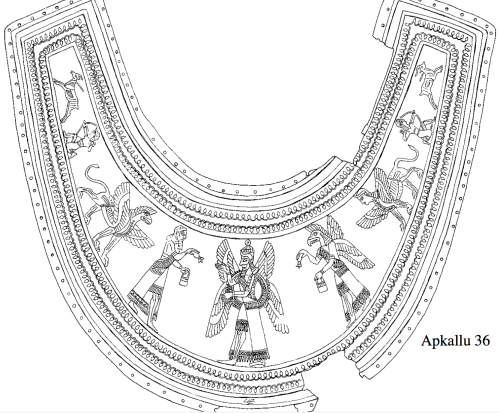
Apkallu type 3, illustration 36, Stephanie Dalley, IDD.
The bird-headed type 3 Nisroc apkallu is on the right, with banduddu bucket in the left hand and an indistinct item in his raised right hand.
The figure on the left lacks wings, though it mimics the blessing gesture and the banduddu bucket of the right-side apkallu. The left side figure may not be an apkallu at all. Perhaps it is a priest. Or a human umu-apkallu. It lacks all symbols of divinity or semi-divinity.
The central figure is problematic for me, wearing a crown which reminds me of a depiction of the god Anu. The problem is that Assyriologists aver that no representations of Anu exist.
Like a bronze artifact depicted on other pages, this one wears a large ring around the torso. This figure also holds a ring in his left hand, or several loops of beads that resemble prayer beads, raising his right hand in the classical gesture of greeting. I will discuss the question of the identity of this deity below.
It usually appears with one or two wings, each perhaps representing a pair of wings; but also with four (80). Like type 1, a pair of mirror-image figures is frequently shown, e.g., on 39*.

Apkallu type 1, illustration 39, Stephanie Dalley, IDD.
Dalley cites this illustration as an example of mirror imaging.
More interesting to me is the fact that the small apkallu depicted in the upper right side of this illustration is wearing a headband rather than the horned tiara seen on the others. This umu-apkallu also holds a sprig of what appear to be poppy bulbs.
In all other respects, the apkallu portrayed on this large wall frieze are typical of the type, except that the detailing of their tassels is exceptionally fine.
As usual, they bless or exorcise the sacred tree at the center of the design with the mullilu cone, banduddu buckets in their left hands.
I must note that unless the real life models depicted in these illustrations and friezes wore a total of four daggers and two whetstones tucked into their waistbands, with two daggers and one whetstone on each side, the original illustrators considered it crucial to portray them. Daggers and whetstones are represented whether the figures are facing left or right.
Some examples show the bird-of-prey-headed Apkallu with a long, high crest as on 76*, which has two ringlets falling on to the shoulder.
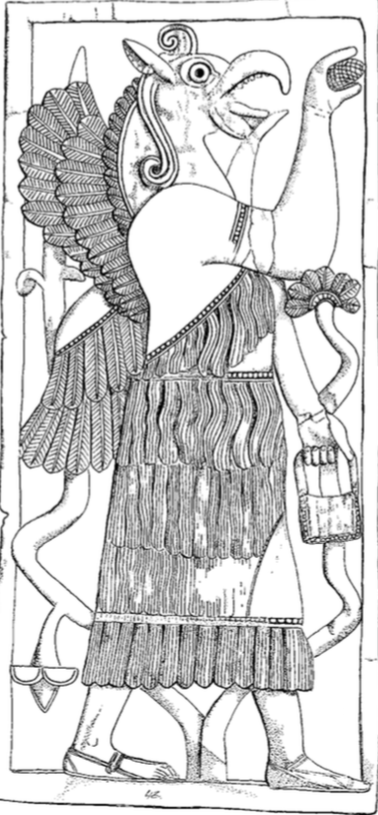
Apkallu type 3, illustration 76, Stephanie Dalley, IDD.
Stephanie Dalley cites illustration 76 as an exemplar “with a long, high crest … with two ringlets falling to the shoulder,” which it indeed does portray.
She also writes, “For jewelry the figure may wear a necklace with seven strands (76*), which may also only be single-stranded with pendants. With my apologies to the professor, I detect no necklace or pendants on this illustration.
This illustration does depict a type 3 Nisroc apkallu in the apparent act of uttering a cry, with a visible tongue, though Professor Dalley does not cite it as an example of that.
Finally, she asserts the “so-called “fish-tail fringe” dangling from the kilt (76*) is not a fish part, and so does not indicate that the type is a fish composite.” With this statement, I am in utter agreement.
This particular illustration, its find site unknown to me, is atypical in other respects. The portrayal of the avian head is perhaps unique, and at variance with the typical versions from the palace walls of the Northwest Palace of Ashurnasirpal II at Nimrud, for example.
The lone curl at the top of the head is unique, I think, as are the curls which Professor Dalley identified above.
In no other example does a nisroc-bird apkallu stand in front of a sacred tree, occluding it from view.
The armlet on this apkallu is unusual, as well, with a design that I have not seen elsewhere.
In all other respects, this depiction of a type 3 bird-headed apkallu is typical, with mullilu cone and banduddu bucket in their customary places.
On other examples there are three curls on top of the head (71*–72, 74, 78*–79).
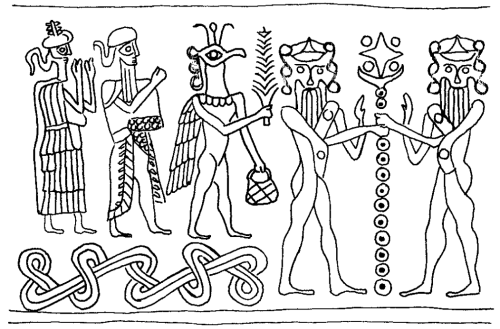
Apkallu type 3, illustration 71, Stephanie Dalley, IDD.
Professor Dalley cites illustration 71 as an example where a nisroc bird-headed apkallu holds a sprig in the raised right hand.
I believe that she also cites it as an example with three curls atop its head. This assertion is problematic, as the middle “curl,” is surmounted by a circle.
Other anomalies abound with this illustration, which depicts a type 3 avian-headed apkallu atypically nude, with an absence of detail on the body.
The banduddu bucket, however, is in its typical place, in the lowered left hand.
The other elements of this illustration will be discussed another time. Several deserve explication, from the identities of the portrayed figures, to the atypical depiction of the sacred tree.
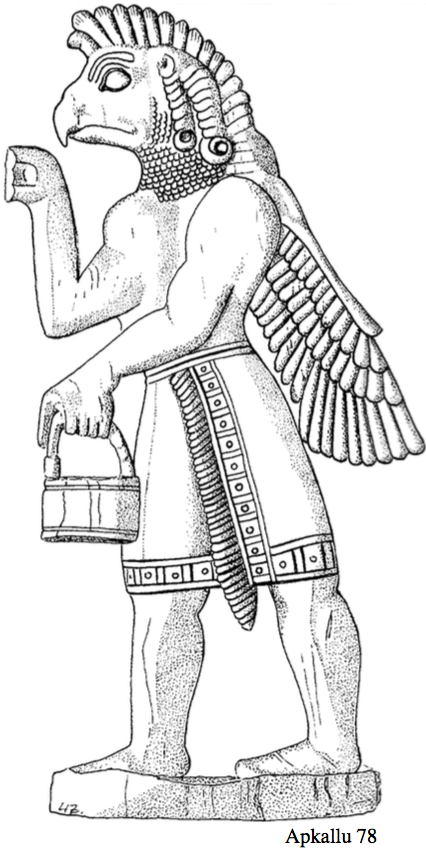
Apkallu type 3, illustration 78, Stephanie Dalley, IDD.
Professor Dalley states that this illustration portrays a bird-headed type 3 apkallu with a plant, which I regretfully do not see. The hand on this illustration is broken off, so whatever was held in the hand is unknown. The hand in fact appears to be in the prototypical gesture of blessing with a mullilu cone in hand, though we cannot be certain. Professor Dalley also states that the “figure appears to pluck a bud or sprig from the sacred tree.” Perhaps.
This illustration, number 78 from IDD, is remarkable for other reasons. For one, the ringlets terminating in a curl at the side of its head are unusual, and the neck area appears to reflect the lone attempt to portray a beard on a bird-headed apkallu in all Assyrian iconography.
This apkallu wears a fringed kilt, but in all other respects it is indicative of the two-winged bird-headed apkallu, with banduddu bucket in the lowered left hand.
For jewelry the figure may wear a necklace with seven strands (76*), which may also only be single-stranded with pendants (7). Rosette bracelets are sometimes shown on each wrist (67).
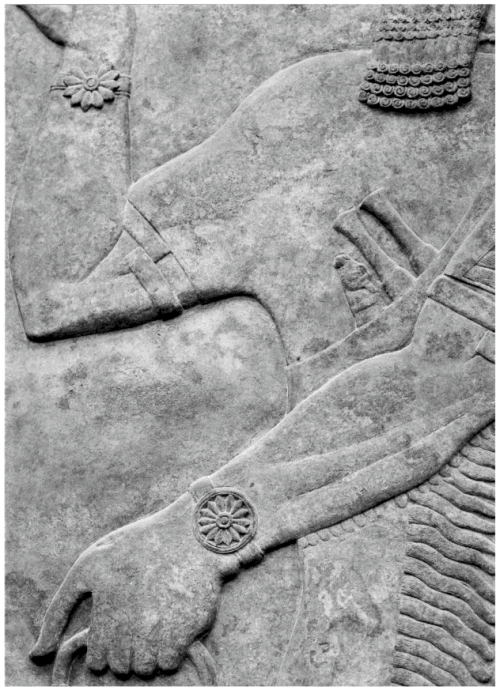
This detail of an umu-apkallu from Panel 12, Room G, Northwest Palace of Ashurnasirpal II at Nimrud focuses on the rosette design of his bracelets.
Note that in this example the bracelets are not matching. In the upper version, the rosette is mounted on a bracelet with no border.
On the example below, the rosette design is circled by a border. The number of petals on the design varies, as well, with eleven petals above and 13 below, by my count.
Armlets at the elbow are clearly visible, as is the fine detailing on the whetstone and the dual daggers in the waistband.
London, British Museum, ANE 124568.
From Mehmet-Ali Atac, The Mythology of Kingship in Neo-Assyrian Art, Cambridge University Press, 2010, p. 109. Photograph by Professor Atac.
The beak is usually closed, but occasionally open to show the tongue (74, 78*–79), as if emitting a cry (80 ). On Late Bronze/Early Iron Age seals the figure is often shown naked (33* – 34*, 47 – 48, 72, 74); at later periods the dress is similar to that of the anthropomorphic sage and the fish-cloak Apkallu on most examples, although the knees are entirely covered by the over-garment on 77.
The so-called “fish-tail fringe” dangling from the kilt (76* above) is not a fish part, and so does not indicate that the type is a fish composite. WIGGERMANN (1992: 75) considers that this type belongs to an Assyrian tradition, and regards all late 2nd millennium examples as Middle Assyrian.
Other deviations from the standard representation include the replacement of the cone in the right hand with a sprig as on 71*. The pose of having both hands raised without holding any object (77) is also unusual. The figure appears to pluck a bud or sprig from the sacred tree on 75*, 78*, and 79.
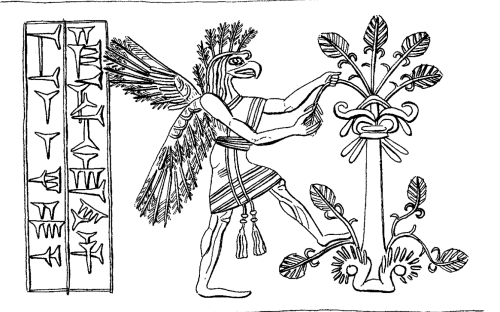
Apkallu type 3, illustration 75, Stephanie Dalley, IDD.
This illustration, number 75, is unique in portraying a type 3 avian-headed apkallu harvesting a leaf or a cone from the sacred tree.
The apkallu goes so far as to plant his left leg against the tree for leverage.
This bird-apkallu is significant for his lone curl at the forehead, and for the emphasis placed on the tassels of his garment.
It should also be observed that this portrayal of the sacred tree depicts leaves, which is unusual.
I also cannot escape the nagging impression that the tree appears to blossom from a vase, with symbology evocative of the fleur-de-lis.
Associations.
A pair of bird-of-prey-headed Apkallus often stands on each side of a sacred tree (7 ) or a royal figure (69 ), or with a plant (78*–79) or a deity (36*, 70 , 74 ), with six-curl heroes holding the sacred tree (71* ).

Apkallu type 3, illustration 36, Stephanie Dalley, IDD.
Professor Dalley cites this illustration, number 36, for the type 1 and type 3 apkallu standing at the flanks of a deity. In the first case, it is far from certain that the figure on the left of the central deity is an apkallu at all, as it lacks all indicators of divinity and most crucially, wings. This figure does raise what appears to be a mullilu cone in its right hand, and it does hold the usual banduddu bucket in his left hand, though it must be admitted that depictions of cones with leaves still attached are irregular.
Unfortunately Professor Dalley does not identify the deity in the center of the illustration, though I am encouraged that she does consider it to be a deity, rather than an apkallu of high rank, which deity I will provisionally attempt to name.
I have discussed elsewhere in captions to these illustrations the possibility that the deity at the center of this composition, which appears to adorn a necklace or breastplate, is the god Anu, who is allegedly never depicted in Mesopotamian iconography.
The circular device at the apex of his crown, which is appropriately horned, is apparent in only one other example that I can call to mind, a bronze face protector or frontal helmet depicted on other pages.
In that example, the circular device or disc is so worn that the lower portion of its mount mimics the inverted crescent of the Moon god Sin.
The context is inappropriate for Sin, however, and in no other case have I ever seen anything positioned between the upturned horns of Sin’s inverted crescent. It is more likely that the disc mount is simply worn from great age, with the circular portion along the top gone.
In any case, a bird-headed type 3 Nisroc apkallu is on the right, with banduddu bucket in the left hand and an indistinct item in his raised right hand. It appears to be a mullilu cone, but with leaves or sprouting, as noted.
As mentioned, the figure on the left side of the deity lacks wings, though it mimics the blessing gesture, cone and banduddu bucket of the right-side apkallu. The left side figure may not be an apkallu at all. Perhaps it is a priest. Or a human umu-apkallu. It lacks all symbols of divinity or semi-divinity.
The central figure remains problematic for me, wearing a crown which reminds me of a depiction of the god Anu. The problem is that Assyriologists aver that no representations of Anu exist.
Also significant for me, this figure, whether it is a deity or an apkallu, wears a large ring around the torso. In the other example which I believe portrays the god Anu, a large ring or circle of this type also wraps the torso of the deity. As is indisputable in the other case, my suspicion is that this ring would also be decorated with rosettes, were sufficient detail feasible for the original illustrator.
This figure also holds a ring or looped prayer beads in his left hand, an item typically reserved for deities, while raising his right hand in the classical gesture of greeting. The griffin demon on the left, and the human-headed sphinx on the right, will have to be explicated elsewhere in a later work.
The figure occurs with type 1 on sequences with three registers at doorways (6*).

Apkallu type 1, illustration 6, Stephanie Dalley, IDD.
This classical depiction of an umu-apkallu includes the mullilu in the raised right hand in the gesture of blessing or exorcism and the banduddu bucket in the left hand.
The horned tiara indicative of divinity may reflect the semi-divine status of the apkallu.
Armlets at the elbow are present, as are wristbands with the typical rosette pattern.
On 72 and 73 an altar is held up by a pair of naked Apkallus (in a very similar scene [MATTHEWS 1990: no. 452] a pair of mermen perform a similar function).

As noted by Professor Dalley, “The type occurs as a group of six or more clay figurines placed in brick boxes in foundations at Assur, Nimrud, and Nineveh,” citing Dessa Rittig as her source (Assyrisch-babylonische Kleinplastik magischer Bedeutung vom 13.-6. Jh. v. Chr. München, 1977).
Assyrian ritual texts describe clay figurines of this type (WIGGERMANN 1992: passim) as foundation figurines buried in groups of seven or more, with black paint, traces of which have occasionally been observed on such clay figurines, including one with black and red stripes painted on the back.”
Stephanie Dalley, “Apkallu,” Iconography of Deities and Demons in the Ancient Near East (IDD), Swiss National Science Foundation, University of Zurich, 2011 (text updated 2011 and illustrations updated 2007), p. 3-4/7.


